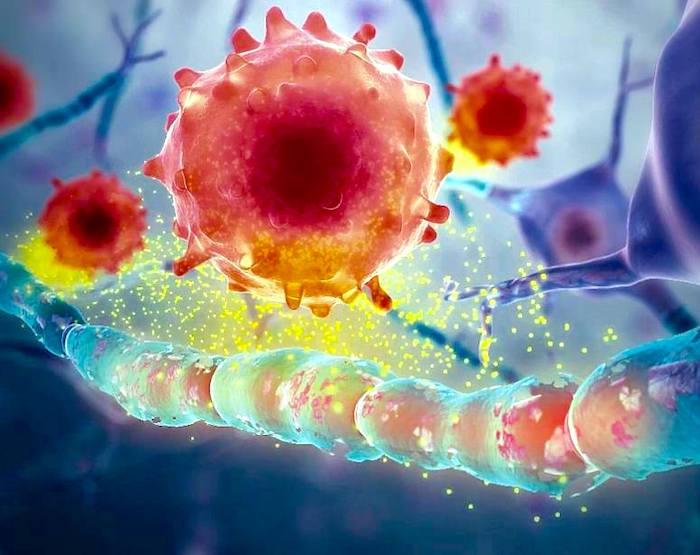 Multiple sclerosis (MS) is a chronic disease in which the immune system attacks the protective layer of myelin that covers and protects nerve fibers, disrupting communication between the brain and body and leading to increasing muscle weakness and paralysis. While there are treatments to slow the progression of the disease, none can reverse damage that has already occurred in brain cells called neurons. New research suggests that the natural compound, ursolic acid – found in a number of herbs and fruits – can reduce further damage to neurons and actually help to rebuild the protective sheaths covering neurons to reverse damage.
Multiple sclerosis (MS) is a chronic disease in which the immune system attacks the protective layer of myelin that covers and protects nerve fibers, disrupting communication between the brain and body and leading to increasing muscle weakness and paralysis. While there are treatments to slow the progression of the disease, none can reverse damage that has already occurred in brain cells called neurons. New research suggests that the natural compound, ursolic acid – found in a number of herbs and fruits – can reduce further damage to neurons and actually help to rebuild the protective sheaths covering neurons to reverse damage.
“Although the evidence is preliminary – our data is from animal models of disease – it’s encouraging to see a compound that both halts and repairs damage in MS, in the lab,” says Guang-Xian Zhang, PhD, co-senior author. The study was published in the Proceedings of the National Academy of Sciences (PNAS) on Monday April 6th.
“There is additional work we must do to test the safety of this compound, but this is a great new lead for disease treatment.”
The researchers used a lab-grade purified form of ursolic acid in mice that had established MS disease. “Many experiments have looked at mice in the acute phase, when disease is just starting or at the peak,” says Dr. Zhang. “Instead, we tested whether this compound was effective in chronic disease, once there has already been chronic damage to tissues of central nervous system.”
The researchers used an established mouse model of multiple sclerosis that develops the disease slowly over the course of its life, mimicking human disease. At about day 12, the mouse begins the acute phase of the disease, when signs of MS, partial paralysis, appear, and when currently-available medications are most effective. The researchers, however, started treating mice at day 60 – a far more advanced stage of the disease when chronic tissue damage has been formed in brain and spinal cords, which needs to be repaired and regenerated.
Researchers treated the mice for 60 days, and began to see an improvement at day 20 of treatment. The mice which were paralyzed at the start of the experiment, regained the ability to walk around again, although with weakness, after treatment.
“It’s not a cure, but if we see a similar response in people, it would represent a significant change in quality of life. And most significantly, it’s a reversal, which we really haven’t seen before with other agents at such a late stage of disease,” says Dr. Zhang.
The researchers also investigated just how ursolic acid acted on cells. They observed that it suppressed Th17 cells – a type of immune cell that is one of the main drivers of the pathological autoimmune response in MS. Many currently active therapies appear to suppress Th17. But the Jefferson researchers showed that the compound could activate precursor cells to mature into much needed myelin-sheath-making cells, called oligodendrocytes.
“This maturation effect is the most crucial,” says Dr. Zhang. “Myelin-sheath-making oligodendrocytes are depleted in MS. And the stem cells that produce new oligodentrocytes are dormant and unable to mature.”
“This compound helps activate those stem cells into making new oligodendrocytes, and is likely responsible for the reversal of symptoms we saw.”
The next steps for the investigators include testing the compound for safety. Although ursolic acid is available as a dietary supplement, it could be toxic at high doses. “There are still a number of tests to complete before the first clinical trials,” says Dr. Rostami. “However, we are moving quickly with this promising approach.”
This study was supported by the NIH, USA (Grants NS099594 and AI135601). Drs. Yuan Zhang and Xing Li were partly supported by Chinese Foundations (Grants 81771345, 31970771 and KF2019001).
Source: Yuan Zhang, Xing Li, Bogoljub Ciric, Mark T. Curtis, Wan-Jun Chen, Abdolmohamad Rostami, Guang-Xian Zhang. A dual effect of ursolic acid to the treatment of multiple sclerosis through both immunomodulation and direct remyelination. Proceedings of the National Academy of Sciences, 2020; 202000208 DOI: 10.1073/pnas.2000208117











